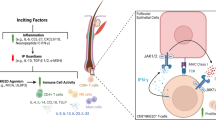Abstract
PURPOSE: Human papillomavirus causes anogenital squamous intraepithelial lesions, warts, and cancer. Treatment of squamous intraepithelial lesions to prevent cancer often requires extensive surgery. We tested a human papillomavirus-specific immunotherapy, HspE7, as a potential alternative. METHODS: HspE7 was constructed by fusing heat shock protein Hsp65 from bacille Calmette-Guerin to E7 protein from human papillomavirus-16. Improvement in pathologic diagnosis of patients with persistent high-grade squamous intraepithelial lesions was studied in an open-label trial (HspE7 500 μg monthly ×3). Anogenital warts were not a trial parameter, but a retrospective review of the medical records of the first 22 patients enrolled at one site was undertaken to estimate the quality and frequency of responses of anogenital warts. Patients with warts by physical examination at baseline were scored at 24 weeks as to the percent reduction in wart size. RESULTS: Fourteen of the 22 patients had warts at baseline. At Week 24, 3 of the 14 patients had complete resolution of their warts, and 10 had warts reduced in size an estimated 70 to 95 percent. The remaining patient’s warts increased in size. The reduction in size in most patients greatly diminished the procedure necessary for complete ablation. No serious or severe adverse events were related to HspE7. CONCLUSIONS: A retrospective review of patients’ medical records suggests that HspE7 may be broadly active in anogenital warts. This activity crosses multiple human papillomavirus types. The warts improved substantially but usually did not totally disappear within six months. Patient follow-up continues. A new randomized, placebo-controlled trial is underway to evaluate these findings.
Similar content being viewed by others
References
InstitutionalAuthorName. (1997) ArticleTitleCase definitions for infectious conditions under public health surveillance. MMWR Morb Mortal Wkly Rep 46 1–55
L Koutsky (1997) ArticleTitleEpidemiology of genital human papillomavirus infection. Am J Med 102 3–8
GY Ho R Bierman L Beardsley CJ Chang RD Burk (1998) ArticleTitleNatural history of cervicovaginal papillomavirus infection in young women. N Engl J Med 338 423–428
KR Beutner DJ Wiley JM Douglas et al. (1999) ArticleTitleGenital warts and their treatment. Clin Infect Dis 28 37–56
KR Beutner A Ferenczy (1997) ArticleTitleTherapeutic approaches to genital warts. Am J Med 102 28–37
PC Langley SK Tyring MH Smith (1999) ArticleTitleThe cost effectiveness of patient-applied versus provider-administered intervention strategies for the treatment of external genital warts. Am J Manag Care 5 69–77
KR Beutner SK Tyring KF Trofatter et al. (1998) ArticleTitleImiquimod, a patient-applied immune-response modifier for treatment of external genital warts. Antimicrob Agents Chemother 42 789–794
CJ Lacey HS Thompson EF Monteiro et al. (1999) ArticleTitlePhase IIa safety and immunogenicity of a therapeutic vaccine, TA-GW, in persons with genital warts. J Infect Dis 179 612–618
L Mizzen (1998) ArticleTitleImmune responses to stress proteins: Biotherapy 10 173–189
NR Chu HB Wu T Wu LJ Boux MI Siegel LA Mizzen (2000) ArticleTitleImmunotherapy of a human papillomavirus (HPV) type 16 E7-expressing tumour by administration of fusion protein comprising Mycobacterium bovis bacille Calmette-Guerin (BCG) hsp65 and HPV16 E7. Clin Exp Immunol 121 216–225
NR Chu HB Wu TC Wu LJ Boux LA Mizzen MI Siegel (2000) ArticleTitleImmunotherapy of a human papillomavirus type 16 E7-expressing tumor by administration of fusion protein comprised of Mycobacterium bovis BCG Hsp65 and HPV16 E7. Cell Stress Chaperones 5 401–405
SE Goldstone B Winkler LJ Ufford E Alt JM Palefsky (2001) ArticleTitleHigh prevalence of anal squamous intraepithelial lesions and squamous-cell carcinoma in men who have sex with men as seen in a surgical practice. Dis Colon Rectum 44 690–698
JM Palefsky EA Holly CJ Hogeboom et al. (1998) ArticleTitleVirologic, immunologic, and clinical parameters in the incidence and progression of anal squamous intraepithelial lesions in HIV-positive and HIV-negative homosexual men. J Acquir Immune Defic Syndr Hum Retrovirol 17 314–319
JM Palefsky EA Holly ML Ralston N Jay (1998) ArticleTitlePrevalence and risk factors for human papillomavirus infection of the anal canal in human immunodeficiency virus (HIV)-positive and HIV-negative homosexual men. J Infect Dis 177 361–367
NB Kiviat CW Critchlow KK Holmes et al. (1993) ArticleTitleAssociation of anal dysplasia and human papillomavirus with immunosuppression and HIV infection among homosexual men. AIDS 7 43–49
Author information
Authors and Affiliations
About this article
Cite this article
Goldstone, S.E., Palefsky, J.M., Winnett, M.T. et al. Activity of HspE7, a Novel Immunotherapy, in Patients with Anogenital Warts. Dis Colon Rectum 45, 502–507 (2002). https://doi.org/10.1007/s10350-004-6229-6
Issue Date:
DOI: https://doi.org/10.1007/s10350-004-6229-6




